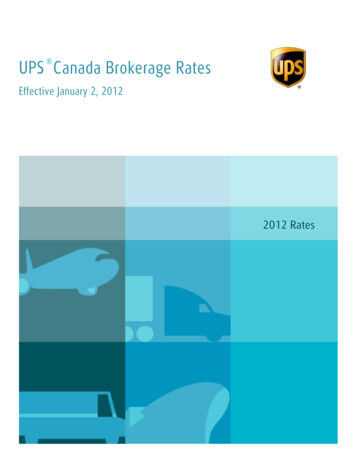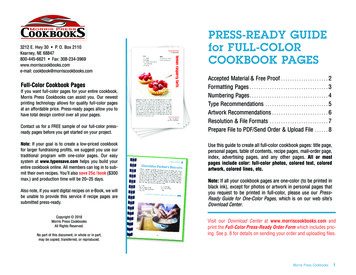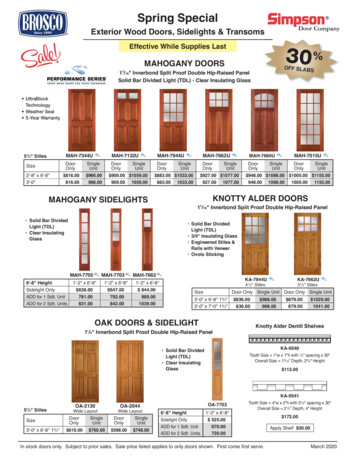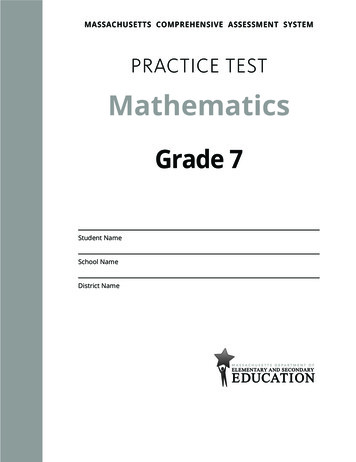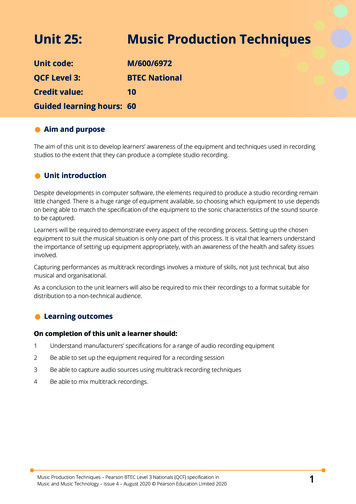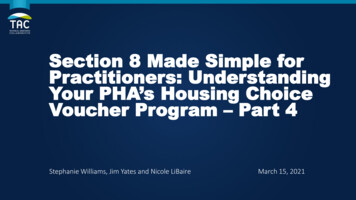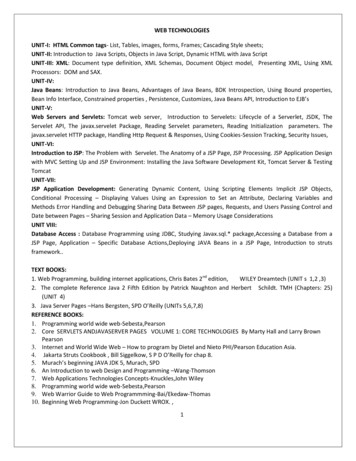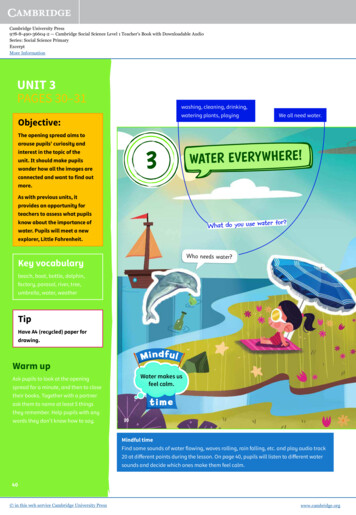
Transcription
Cambridge University Press978-8-490-36604-2 — Cambridge Social Science Level 1 Teacher's Book with Downloadable AudioSeries: Social Science PrimaryExcerptMore InformationUNIT 3PAGES 30–31washing, cleaning, drinking,watering plants, playingWe all need water.Objective:The opening spread aims toarouse pupils’ curiosity andinterest in the topic of theunit. It should make pupilswonder how all the images areconnected and want to find outmore.3As with previous units, itprovides an opportunity forteachers to assess what pupilsknow about the importance ofwater. Pupils will meet a newexplorer, Little Fahrenheit.WATER EVERYWHERE!What do you use water for?Who needs water?Key vocabularybeach, boat, bottle, dolphin,factory, parasol, river, tree,umbrella, water, weatherTipHave A4 (recycled) paper fordrawing.Min dfulWarm upAsk pupils to look at the openingspread for a minute, and then to closetheir books. Together with a partnerask them to name at least 5 thingsthey remember. Help pupils with anywords they don’t know how to say.Water makes usfeel calm.time30Mindful timeFind some sounds of water flowing, waves rolling, rain falling, etc. and play audio track20 at different points during the lesson. On page 40, pupils will listen to different watersounds and decide which ones make them feel calm.40 in this web service Cambridge University Presswww.cambridge.org
Cambridge University Press978-8-490-36604-2 — Cambridge Social Science Level 1 Teacher's Book with Downloadable AudioSeries: Social Science PrimaryExcerptMore InformationMain concepts Ask what pupils think this unitwill be about. Read the scatteredquestions and have a simplediscussion about water.Because all living things need water to live. Ask pupils the difference betweenWho? What? Why? and Where? in thequestions.Water, water everywhere! Point to elements in the illustrationand ask how they are connected tothe unit. Focus attention on the twocharacters. Ask why Little Armstrongis not well. Ask pupils to look back topage 4 and find out the name of thenew character and what he likes.Why is water important?Learn more Watch the documentary andencourage pupils to react to it. Askhow the girl’s life collecting wateris different from theirs and how itmakes them feel. Encourage pupils to fold an A4paper in half. On one side havepupils draw how the girl gets waterand on the other, how they get theirwater.Where does water come from?SongThe song lists the different wayswe use water and reinforcesvocabulary. It also sends themessage that we mustn’t wastewater!D CUMENTARYWater for life31DocumentaryThe documentary shows how wemust look after water.It is recycled from lakes, rivers and seas.41 in this web service Cambridge University Presswww.cambridge.org
Cambridge University Press978-8-490-36604-2 — Cambridge Social Science Level 1 Teacher's Book with Downloadable AudioSeries: Social Science PrimaryExcerptMore InformationUNIT 3PAGE 32Objective:ponds, lakes, rivers, seas,oceans, rain, and tapsa sea b lake c river d pondPupils will learn that there aredifferent bodies of water onEarth.WHERE CAN YOU FINDWATER ON EARTH?Key vocabularyLook and match.FindFindoutsealake, pond, river, seaWarm upIntroduce Mindful time. Play thesound of flowing water. Have pupilsclose their eyes for a minute. Askhow the sound makes them feel andwhat it makes them think about. AskWhere do you hear water? Write keyvocabulary on the board.lakeSeas, lakes, riversand ponds are allbodies of water.Main concepts Ask if they can name the bodiesof water on the page. Play theaudio and have pupils match thewords and photos. Talk about thedifferences between the bodies ofwater.terCan you find wain other places?riverpond Call out the different names on thepage and have pupils point to thecorrect photo. Do they know thenames of any rivers, lakes or seas?FUN FACTThere is a lot ofwater in your body! Ask Can you find water in otherplaces? Pupils share their ideas.32Learn more Talk about what activities you cando on a pond, lake, river and sea.Here's the hidden sun!Yes. In water bottles, toilets, washing machines,snow, ice, our body, etc. Read and discuss the Fun Fact.42 in this web service Cambridge University Presswww.cambridge.org
Cambridge University Press978-8-490-36604-2 — Cambridge Social Science Level 1 Teacher's Book with Downloadable AudioSeries: Social Science PrimaryExcerptMore InformationUNIT 3PAGE 33Europe, South America,Africa, North AmericaObjective:Pupils will discover the namesof some well-known rivers andlakes, and locate them.Try itoutMini-MYDICTIONARYLet’s discover bodies of water.Key vocabulary1 Look at a globe and point to bodies of water.body of water, continent, lake,pond, river, sealakeWarm upPlay Hangman with the key wordsfrom the previous class.pondMain concepts2 Find out which continent the following riversand lakes are in. Complete the table.Bodyof ganContinent Pupils review names of continentsand oceans using maps or globes.river Say Let’s discover bodies of water!Read the names of the lakes andrivers in the table. Explain thateach body of water is on a differentcontinent. Pupils look and locatethem.sea Check answers together beforepupils fill in the table.Learn moreAland a s,ar,apwater.ofare all bodies,33A lake, a pond, a river and a seaare all bodies of water. Ask each group to locate anotherbody of water on their own and addit to the table. Read My dictionary as a class. Askpupils to find the sticker and tracethe words. Ask pupils to read and complete theWhat have I learnt? box individually.43 in this web service Cambridge University Presswww.cambridge.org
Cambridge University Press978-8-490-36604-2 — Cambridge Social Science Level 1 Teacher's Book with Downloadable AudioSeries: Social Science PrimaryExcerptMore InformationUNIT 3PAGE 34to wash, clean, and drinkObjective:Pupils will identify where thewater in our homes comes fromand the different ways it is used.FindFindoutWHY DO WE NEED WATER?Listen and point.Key vocabularyclothes, dishes, shower, tap, toiletWarm upHave pupils stand around a tap orwater fountain. Discuss where pupilsthink the water comes from and howit arrives at our homes and school. Askwhy we need water.We cannot drink contaminated water.We need to clean it first.Main conceptsmes?t our hoaeivrrraes wateHow do Pupils look at the photos and namethings they know with a partner. Play the audio and have pupilspoint to each picture. Play the audioa second time, stopping after eachdescription for pupils to repeat.TipTurn off the tap.Don’t waste water! Ask How does water arrive at ourhomes? Focus pupils’ attention onthe reservoir and let them explain. Ask what would happen if we drankcontaminated water.TipTake short showers.Learn more Discuss the importance of notwasting water and why. Play the song Water, watereverywhere while pupils mime theactions.34It comes from reservoirs, is cleaned(and treated) and comes throughpipes into our house.44 in this web service Cambridge University Presswww.cambridge.org
Cambridge University Press978-8-490-36604-2 — Cambridge Social Science Level 1 Teacher's Book with Downloadable AudioSeries: Social Science PrimaryExcerptMore InformationUNIT 3PAGE 35Objective:Pupils will carry out a simpleexperiment to understand theproperties of water.Try itoutLet’s learn more about water.Key vocabulary1 Look at and smell a glass of water and a glass of orange juice.colour, glass, orange juice, smell,tasteWarm upPresent a glass with clean water, andone with dirty water. Ask pupils to lookand describe the water. Ask pupilsto describe what they think the dirtywater tastes like. Let pupils also smellthe dirty water and describe the smell.2 Taste the water and the orange juice.Main concepts Say Let’s learn more about water.Read the instructions together andask a volunteer to explain what theywill do. Pupils should work in pairs. Giveeach pair a glass of water and aglass of orange juice. Explain theymust look, smell, taste and compare.ConclusionRead and circle.Orange juice / Water has no colour.Orange juice / Water has no smell.Orange juice / Water has no taste.35Water has no colour, smell or taste! After the experiment, call outdifferent statements It is orange. / Ithas no colour. / It has no smell. etc.and have pupils respond with thecorrect answer. Read the conclusion together andhave pupils circle the correct words.Learn morePlay the chant Water in my glass.45 in this web service Cambridge University Presswww.cambridge.org
Cambridge University Press978-8-490-36604-2 — Cambridge Social Science Level 1 Teacher's Book with Downloadable AudioSeries: Social Science PrimaryExcerptMore InformationUNIT 3PAGE 36Look outside!It’s on page 32.Objective:Pupils will learn to identify andtalk about different types ofweather.WHAT’S THE WEATHER LIKE TODAY?Key vocabularyDraw the weather today.FindFindoutFind the sun hidden in the unit!cloudy, rainy, snowy, stormy,sunny, windysnowysunnyWarm upPlay Hangman with the word weather.Look out of the window and say What’sthe weather like today? Elicit responses.windyMain conceptsstormy Ask pupils to look at the weatherphotos and to read each word witha partner.cloudy Play the audio and have pupilspoint. Play again, stopping aftereach word so pupils can repeat it.rainy Hold up one weather flashcard at atime and ask What’s the weather like?Encourage pupils to reply with It’s .Give volunteers a chance to ask thequestion.FUN FACTRainbows come out when it is rainyand sunny at the same time.What’s the weatherlike today?It’s If you have brought items linked tothe weather, hold these up and askWhat’s the weather like?36Learn more Look out of the window again,and have pupils tell you what theweather is like, before they draw itin their books. Read and discuss the Fun Fact.46 in this web service Cambridge University Presswww.cambridge.org
Cambridge University Press978-8-490-36604-2 — Cambridge Social Science Level 1 Teacher's Book with Downloadable AudioSeries: Social Science PrimaryExcerptMore InformationUNIT 3PAGE 37Objective:Pupils will make a rain gauge toobserve rainfall.Try itoutMini-Key vocabularyMYDICTIONARYLet’s make a rain gauge.bottle, cloudy, measure,playground, rain, rain gauge,rainy, snowy, sunny, windy1 Cut the top part off a bottle. Place it inthe bottom part of the bottle.cloudy2 Put your rain gauge in the playground andmeasure it when it rains.Warm upPlace weather flashcards aroundthe room. Pupils ask you What’s theweather like? When you respond, theypoint to the correct flashcard.rainyMain concepts Show the rain gauge flashcard. AskWhat is it?snowy Say Let’s make a rain gauge.Demonstrate and show how tomark centimetres on the side. Pupilsprepare their rain gauges.sunnyKeep a record ofthe rain for a week.Weather changes. It can be, clsu.snIt can also be ror stormy.wor Label the bottles before finding aplace for them outside.Learn morewindy,37Weather changes. It can be sunny, cloudy or snowy.It can also be rainy, windy or stormy.Pupils create a table with days of theweek (or Week 1/Week 2, etc.) acrossthe top, and centimetres markeddown the side. Read My dictionary as a class. Askpupils to find the sticker and tracethe words. Ask pupils to read and complete theWhat have I learnt? box individually.47 in this web service Cambridge University Presswww.cambridge.org
Cambridge University Press978-8-490-36604-2 — Cambridge Social Science Level 1 Teacher's Book with Downloadable AudioSeries: Social Science PrimaryExcerptMore InformationUNIT 3PAGE 38They like clean air because it’s healthy and helps them grow.picture BObjective:Pupils will understand theimportance of looking after theair and the consequences of notdoing so.DO TREES LIKE CLEAN OR DIRTY AIR?Colour the river.Key vocabularyAsmokeFindFindoutWhich picture shows clean energy?air, factory, plane, smoke, tree,wind turbineWarm up Play Hangman with the wordcontamination and see whetherpupils remember what it is. Explain we can have contaminatedwater and contaminated air.treefactoryBMain concepts Give pupils a whispering minute totalk about the pictures. Ask what the differences are betweenthe two scenes. Focus on the firstpicture and ask why the air is dirty. Ask pupils to point to the river andcolour it.wind turbine Read the title question and questionson the page. Discuss as a class.Learn moreTake the pupils outside or open awindow. Ask if they think the air isclean or dirty. If it is clean, do somesimple breathing exercises together.If pupils think it is dirty, ask how theycan protect themselves.see plants in?Which picture can you38picture B48 in this web service Cambridge University Presswww.cambridge.org
Cambridge University Press978-8-490-36604-2 — Cambridge Social Science Level 1 Teacher's Book with Downloadable AudioSeries: Social Science PrimaryExcerptMore InformationUNIT 3PAGE 39Objective:Try itoutMiniLet’s be planet superheroes.Pupils will understand trees areimportant for the planet andthat they help keep the air clean.MYDICTIONARYKey vocabulary1 With your teacher and classmates, dig a holein the playground and plant a tree.dig, factory, grow, hole, plant,smoke, tree, wind turbinefactorießWarm upSay Dig a hole, plant a tree, fill in thehole, water the tree and watch it grow,and mime each of the actions as yousay them. Pupils join in.smoke2 Water your tree and watch it grow.Main concepts Elicit pupils’ favourite superheroes.You will be planet superheroes!treeß Together, plant the tree and talkabout what it needs.Learn morewindturbineßlike clean air and water.Tmake clean energy.Wind tis bad forThe smoke from four planet. Measure the tree and count itsbranches. In their notebooks, pupilswrite the date and draw the tree.Later in the year, pupils draw thetree again.Keep a recordand observe howyour tree grows.39 Read My dictionary as a class. Askpupils to find the sticker and tracethe words. Ask pupils to read and complete theWhat have I learnt? box individually.Trees like clean air and water. Wind turbines make clean energy.The smoke from factories is bad for our planet.49 in this web service Cambridge University Presswww.cambridge.org
Cambridge University Press978-8-490-36604-2 — Cambridge Social Science Level 1 Teacher's Book with Downloadable AudioSeries: Social Science PrimaryExcerptMore InformationUNIT 3PAGE 40Pupils’ own answersObjective:Pupils will reflect on howdifferent water sounds makethem feel and think about thecorrect use of water.Attitude is everythingListen. Tick ( ) the sounds that make you feel calm.acbKey vocabularycalm, feel, waterWarm updPlay the chant Water in my glass andhave pupils mime looking, smellingand tasting it. Ask if the water is cleanor contaminated.eMain concepts Books closed. Play audio track 26.Stop after each water sound and askpupils what they can hear. Play thewater sounds again and ask whichones make them feel calm.Circle the correct uses of water.abcd Books open. Ask pupils to look atthe photos and tick the boxes. Focus on each picture in Activity2 and talk about what the childis doing and whether it is goodbehaviour or not. Have them circlethe good behaviour.Learn more Ask pupils to tell a partner the differentways we use water. Provide thesentence starter We use water to .40a and c Mime with pupils: putting ontoothpaste, wetting the toothbrush,and turning off the tap.50 in this web service Cambridge University Presswww.cambridge.org
Cambridge University Press978-8-490-36604-2 — Cambridge Social Science Level 1 Teacher's Book with Downloadable AudioSeries: Social Science PrimaryExcerptMore InformationUNIT 3PAGE 41a nob noc yesd yesThis activity gives pupils practice of Pre A1 Starters Reading and Writing Part 2.Objective:Now I knowLook and write yes or no.Go to page 82 for more activities.Pupils will review the content ofthe unit and read about DanielGabriel Fahrenheit.Key vocabularylake, river, sunny, weather, windturbine, windyWarm upabcdIt is sunny by the sea.There are four wind turbines in the mountains.It is windy by the lake.The river goes into the lake.Using weather flashcards, hold themup one by one and have pupils shoutout the weather e.g. It’s sunny!Listen and tick ( ) the box.1 Where is Annie?Main conceptsbc2 What is the weather like?caaWater in my glassb Ask volunteers to describe what theysee in the picture in Activity 1. Pupilscomplete the task individually andcompare answers. Discuss the photos in Activity 2. AskWhat can you see in each one? Ask avolunteer to explain what they mustdo. Play the audio twice, pausing asnecessary. As a class, look at the photo ofDaniel Gabriel Fahrenheit and readthe information.I am Daniel GabrielFahrenheit.Learn moreI invented the thermometer.411 b2 bThis activity gives pupils practice of Pre A1 Starters ListeningPart 3. Use the internet to look for moreinformation about Daniel GabrielFahrenheit. Pupils can now put their fingerprintin the passport on page 5.51 in this web service Cambridge University Presswww.cambridge.org
Cambridge University Press978-8-490-36604-2 — Cambridge Social Science Level 1 Teacher's Book with Downloadable AudioSeries: Social Science PrimaryExcerptMore InformationUNIT 3 LET’S REVIEW PAGE 82Find the right words answers1a binb showers2a Yes, it is.b No, it isn’t.c Yes, it is.Look back answers1a nob yesc yesd noe yesThis activity gives pupils practice of Pre A1 Starters Reading and Writing Part 2.2a seab riverc lake52 in this web service Cambridge University Presswww.cambridge.org
Cambridge University Press978-8-490-36604-2 — Cambridge Social Science Level 1 Teacher's Book with Downloadable AudioSeries: Social Science PrimaryExcerptMore InformationUNIT 3 TRACKLISTTrack 20Track 21Track 22Track 23Track 24Track 25Track 26Track 27Track 28Track 29Track 57Page 30, Mindful time. Water makes us feel calm.Page 31, Song Water, water everywhere!Page 32, Where can you find water on Earth?Page 34, Why do we need water?Page 36, What’s the weather like today?Page 38, Do trees like clean or dirty air?Page 40, Listening activityPage 41, Listening activityPage 41, Chant Water in my glassPage 41, I am Daniel Gabriel Fahrenheit CharacterPage 82, Listening activity53 in this web service Cambridge University Presswww.cambridge.org
sunny windy UNIT 3 PAGE 37 Objective: Pupils will make a rain gauge to observe rainfall. Key vocabulary bottle, cloudy, measure, playground, rain, rain gauge, rainy, snowy, sunny, windy Warm up Place weather flashcards around the room. Pupils ask you What s the weather like? When you re


